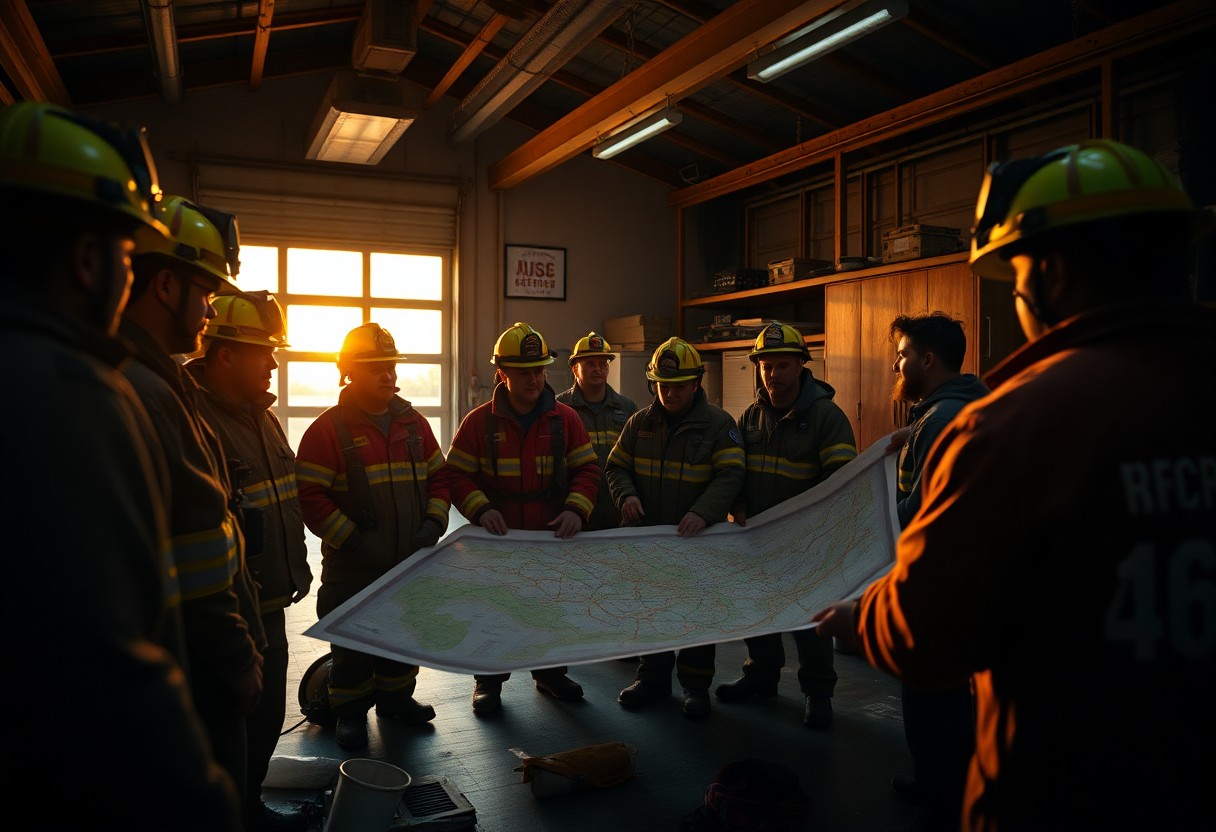This guide will help you enhance teamwork and foster a positive environment within your volunteer fire department. By focusing on effective communication, shared goals, and mutual respect, you can cultivate an atmosphere where every member feels valued and engaged. Explore strategies to build strong relationships among your team, improving response times and overall effectiveness during emergencies. Strong collaboration not only benefits your department but also significantly impacts the community you serve. Let’s dive in and explore how you can take your team’s collaboration to the next level!
Understanding the Importance of Collaboration
While the essence of a successful volunteer fire department lies in readiness and response, the foundation is built on effective collaboration. Working together fosters a sense of camaraderie and trust among team members, enhancing communication during high-pressure situations. Collaboration allows for diverse perspectives and skills to coalesce, which can lead to more innovative solutions. As a result, team members feel valued and engaged, creating a stronger, more unified department.
Benefits of Teamwork in Fire Departments
Little can be overstated about the impact of teamwork in fire departments. Strong collaboration leads to improved safety, better decision-making, and increased efficiency during emergencies. When team members work closely together, they harness their combined strengths, ultimately saving lives and property. Furthermore, a united team enhances morale and fosters a supportive environment.
Factors Influencing Collaborative Efforts
There’s a range of factors that can impact your volunteer fire department’s collaborative efforts. These include:
- Leadership style
- Communication practices
- Shared goals
- Training opportunities
The environment you create significantly affects collaboration.
Collaborative efforts can also be influenced by several other contextual factors. These include:
- Organizational culture
- Access to resources
- Individual skill sets
- Community support
The harmony within your team can vastly improve when these factors are aligned.
Tips for Building a Collaborative Culture
Even in a volunteer fire department, fostering a collaborative culture can significantly enhance team effectiveness. To achieve this, consider the following tips:
- Encourage open dialogue
- Recognize individual contributions
- Foster team-building activities
- Implement regular feedback sessions
- Establish clear goals and expectations
This approach will cultivate an environment where collaboration thrives.
Foster Open Communication
To encourage a culture of collaboration, prioritize fostering open communication among your team members. Create avenues for your firefighters to express their thoughts, ideas, and concerns openly. Regular meetings, accessible communication platforms, and a non-judgmental atmosphere can help facilitate this trust and openness.
Encourage Inclusivity and Respect
Open dialogue within your fire department should always emphasize inclusivity and respect. By ensuring all voices are heard, you create a sense of belonging that invites diverse perspectives and ideas. Each member brings their unique experiences, which enriches decision-making and problem-solving processes.
Understanding the importance of inclusivity and respect is necessary for teamwork in a volunteer fire department. When you promote a culture where every member feels valued and respected, you empower them to contribute their best. This environment not only enhances teamwork but also fosters greater commitment and motivation to achieve common goals, making your operations more effective and cohesive.
Developing Leadership Skills for Collaboration
Any effective collaboration within your volunteer fire department starts with developing strong leadership skills among your members. By empowering individuals to take on leadership roles, you create a culture where teamwork thrives. Focus on fostering qualities such as communication, accountability, and problem-solving to enhance collaboration. Encourage your members to be open to feedback and actively participate in decision-making processes. When everyone feels valued and respected, you can build a cohesive team that works seamlessly together.
Training and Development Opportunities
Training is crucial to equip your members with the necessary leadership skills. Consider organizing workshops, seminars, or training sessions that focus on collaboration and teamwork dynamics. Involvement in these programs can help develop critical thinking, adaptability, and conflict resolution skills, fostering a more unified team. Additionally, seek out opportunities from experienced leaders in other departments who can share their knowledge and provide mentorship.
Leading by Example
Skills develop best when they are modeled effectively, and you can do this by leading by example. A leader who demonstrates commitment, integrity, and collaboration sets a powerful standard for others to follow. By consistently showing up for your team, making informed decisions, and communicating openly, you foster trust and respect. Your actions should reflect the values you want to instill in your team. When challenges arise, showcase your problem-solving ability and your willingness to support others, creating an environment that encourages teamwork and collective success.
Implementing Collaborative Tools and Strategies
Now, implementing collaborative tools and strategies is imperative for fostering teamwork within your volunteer fire department. Begin by assessing your current communication methods and identifying areas that could benefit from enhanced collaboration. Incorporate regular meetings, brainstorming sessions, and online platforms where members can share ideas, updates, and resources seamlessly. This intentional approach will help create a supportive environment that encourages teamwork and shared responsibility.
Utilizing Technology for Team Coordination
While traditional communication methods are valuable, leveraging technology can significantly enhance your team’s coordination. Consider using apps for scheduling, messaging, and sharing training materials. This not only streamlines communication but also ensures that all members have access to important information in real-time, improving your department’s overall efficiency.
Establishing Clear Goals and Roles
An effective way to cultivate collaboration is by establishing clear goals and roles within your team. By defining each member’s responsibilities, you minimize confusion and ensure that everyone knows what is expected of them. This transparency fosters accountability, allowing your team to work towards a common objective with a shared sense of purpose.
Clear goals give your team a focused direction and boost motivation while unambiguous roles help to avoid overlap and misunderstandings. To enhance this process, consider conducting a workshop to discuss and establish these goals, enabling members to contribute their insights. By actively involving your team, you promote a collaborative culture where everyone feels valued and empowered to contribute positively to the department’s mission. Ultimately, this clarity enhances overall performance and ensures that you are well-prepared for any emergency situation.
Engaging Volunteers in the Collaborative Process
After fostering an environment where collaboration thrives, it’s imperative for you to actively engage your volunteers in the collaborative process. Begin by creating opportunities for them to contribute their thoughts, ideas, and skills. By involving them in decision-making and problem-solving activities, you not only enhance their commitment but also nurture a sense of ownership and accountability. This active involvement can lead to improved morale and a cohesive team spirit that benefits your entire volunteer fire department.
Seeking Input and Feedback
The success of your collaboration efforts hinges on actively seeking input and feedback from your volunteers. Encourage an open dialogue, where everyone feels valued and heard. Implement regular meetings and feedback sessions to discuss ongoing projects and gather insights. By demonstrating that you consider their opinions important, you build trust and foster a collaborative culture within your department.
Recognizing Contributions and Achievements
If you want to maintain high motivation levels among your volunteers, it’s imperative to recognize their contributions and achievements. Regular acknowledgment of their hard work not only boosts morale, but it also reinforces the importance of collaboration within the team.
Feedback plays a vital role in creating a supportive atmosphere. When you recognize the efforts of your volunteers, whether through verbal praise, awards, or public announcements, it cultivates a positive culture that appreciates teamwork. Make it a practice to celebrate even the small wins; doing so not only boosts individual confidence but also emphasizes how collaboration leads to collective success. By highlighting valuable contributions, you encourage others to participate actively, ensuring your fire department continues to work as a unified force during emergencies.
Measuring Success in Collaboration
Unlike traditional metrics, evaluating collaboration in your volunteer fire department should focus on both qualitative and quantitative outcomes. Consider factors such as improved communication, enhanced teamwork, and increased morale among members. Tracking these elements will help you gauge how effectively your department collaborates and identify areas that may need attention or resources.
Tracking Progress and Outcomes
Success in collaboration is marked by clear indicators that demonstrate how well your team is working together. Use regular surveys, feedback sessions, and performance assessments to collect data on team dynamics and operational effectiveness. These tools will provide you with valuable insights into your department’s overall performance and areas for improvement.
Adjusting Strategies as Needed
Any successful collaboration requires flexibility and adaptability. Evaluating your team’s performance regularly will enable you to identify challenges and adjust your strategies accordingly.
Understanding that collaboration is an ongoing process allows you to assess your team’s dynamics and outcomes actively. By routinely soliciting feedback from your members, you can pinpoint areas of concern and positive developments. This iterative approach gives you the opportunity to make adjustments to your methods, ultimately ensuring that your volunteer fire department continues to foster a culture of innovation and teamwork.
Final Words
As a reminder, fostering collaboration within your volunteer fire department enhances efficiency and builds a strong sense of community. By actively encouraging open communication, facilitating team-building activities, and recognizing the contributions of each member, you can create an environment where everyone feels valued and motivated. Emphasizing shared goals and promoting inclusivity will not only improve teamwork but also enhance your department’s overall effectiveness. Keep striving to cultivate a collaborative spirit, as it will lead to a more resilient and responsive team in times of need.
Q: What are some effective strategies to promote teamwork among volunteers in a fire department?
A: To foster teamwork among volunteers, consider organizing regular team-building activities that include both physical training and social events. These activities help build camaraderie and trust, which are vital for effective collaboration during emergencies. Additionally, setting up clear communication channels such as group messaging apps or regular meetings can facilitate coordination and ensure everyone is on the same page. Encourage members to participate in decision-making processes so they feel valued and their contributions are recognized.
Q: How can leadership influence collaboration within a volunteer fire department?
A: Leadership plays a significant role in shaping the collaborative culture of a volunteer fire department. Leaders should model collaborative behavior by actively engaging with volunteers, demonstrating respect for their ideas, and fostering an inclusive environment. Providing constructive feedback and acknowledging the efforts of team members can enhance motivation and teamwork. Furthermore, leaders should strive to create a shared vision that emphasizes the importance of collective efforts towards common goals, empowering volunteers to feel more connected to the department’s mission.
Q: What role does training and development play in enhancing collaboration among firefighters?
A: Training and development are instrumental in enhancing collaboration within the fire department. Implementing regular training sessions that emphasize team dynamics and joint problem-solving can improve communication and effective coordination during emergency responses. Consider introducing cross-training opportunities so that members can learn different roles within the department, fostering appreciation for each other’s skills and responsibilities. This not only builds a more versatile team but also encourages volunteers to rely on one another, ultimately leading to a stronger, more collaborative unit.



